
The old bridge near the backpackers facility in Maun.
Our safari started at Old Bridge Backpackers. They organize the tours in partnership with the Lebolu Safari outfit we had chosen.
Everyone who knows me, or reads this blog, knows I always recommend do-it-yourself travel. However, in Africa I hedged my bets and decided on a mobile safari. Until I got there and saw how difficult it is to navigate on one’s own, I still wasn’t sure I’d made the right decision. After all, many people from all over the world come here, rent a safari vehicle and head out on their own. (If you decide you want to do it yourself, contact me for info). The plus of driving yourself is you can decide to go or stay whenever you like. The downside is public camping is limited, the roads are often impassible, sign posts nearly non-existent and the best campsites are available only to the tour operators. Rental safari equipped vehicles aren’t cheap, park fees and public camping facilities are high. Buying your own fuel (petrol is pricey) and groceries, plus tending to camp life during peak viewing hours is problematic. Having GPS and a satellite phone are necessities, but assistance is often many miles, even days away. Not much help if an elephant has just upended your car. Knowledge of the temperament and aggressiveness of the different animals is crucial. The guides know this, plus where and how to find the wildlife.
It is expensive to visit Africa, and the airfare is only the beginning. Wilderness lodges are very pricey. Safaris aren’t cheap either, but you can find some outfits that are reasonable. Be sure to check local operators. We had excellent guides, a cook, and camp manager to take care of us for less per day than most lodges. Camp was set up for us and meals were cooked while we were out looking for wildlife. We felt like royalty. We expected to be bothered by insects, but it wasn’t much of a problem.
Our first destination was Deception Valley in the Kalahari Game Reserve. On the road to the game reserve it’s interesting to see how the rural people live. Because there was a hoof and mouth outbreak some years ago, the government gave ranchers the option of replacing their cattle with donkeys which don’t get the disease. Along the highway verges are lots of cattle, donkeys, and goats. Driving amid the animals and potholes is a challenge.

Rural life still includes many living in traditional huts. Some are now building with cement blocks.

Cattle, donkeys and goats share the highways frequently.

Lunch on the way at a road side picnic area. These are generally a mess because garbage isn’t picked up often and the birds and animals scatter trash.

And into the Kalahari game reserve

This man pumped the gas. Craig couldn’t talk him out of his fancy hat.

A fork-tailed drongo guarded the entrance gate.
Once in the reserve, camp was set up quickly. Here are a few pictures of camp life….
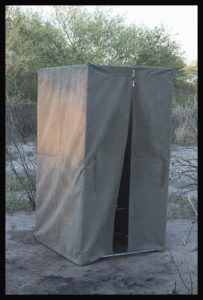
Camp privy.

Our tent. The others have theirs pitched on the other side near the kitchen area.
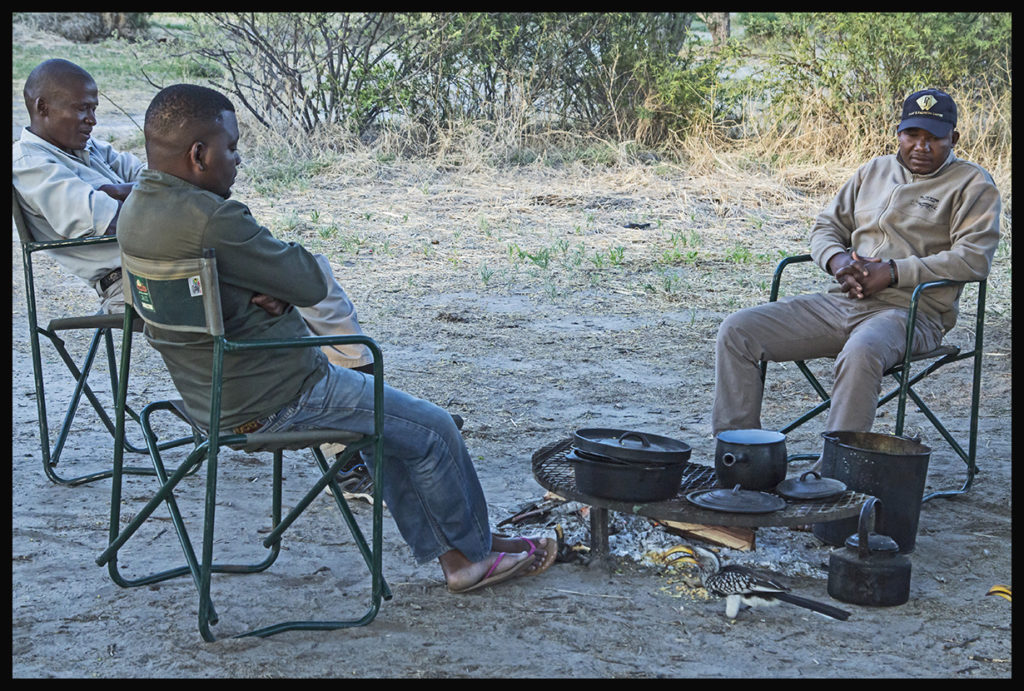
The cooking area with our staff and hornbill looking on.

Camp staff posing for the camera.
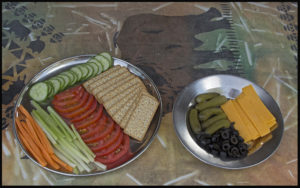
The tea time snack before the afternoon game drive. We never went hungry. Food was nutritious and plentiful.
Birds in camp kept me entertained. The weavers, and there are lots of species in Botswana, are an interesting group. Like our orioles they build intricate nests. Watching the birds weave is amazing. They build the nests on the tips of branches to prevent larger animals and snakes from getting the eggs and young. It’s now known they all pitch in to build the main nest and the nests vary from colony to colony…a sort of cultural construction technique. The dominant female lays the eggs. The others help feed the young and sleep in U-shaped roosts that have openings on both ends. Because the winds are normally from the east, the nests are always on the west side of the tree. It’s a useful natural compass.

White-browed sparrow-weaver.

Nest entry way.

Nest colony of the sparrow-weaver.

Swallow tailed Bee-eater.

Violet-eared Waxbill

A common beauty, the Crimson-breasted Shrike
Here is a sample of what we saw on our drives around the reserve….

A Deception Valley pan. Pans are flat, open depressions that flood when the rains come. Travel is limited when pans are full.

Two males were hiding under some bushes when our eagle eyed guide, Joseph, spotted them. They casually strolled off.

Southern pale chanting goshawk.

Cheetah male.

Gemsbok, aka Oryx. Beautiful desert-adapted antelopes. They rarely urinate and when they do it’s more of a honey consistency.

The Cape penduline-tit makes the most cunning nest I’ve ever seen.
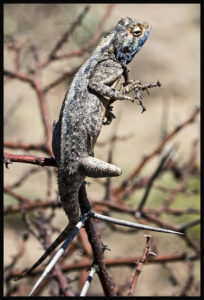
I didn’t see a lot of lizards which was a surprise.

Bat eared fox. Very small, cute foxes. Mother guards her den with kits inside.

Crowned Lapwing or Plover.

Lapwing nest, a scrape in the pan. These birds do the “broken wing” trick to divert predators.

Secretarybird, my favorite! The pin feathers sticking up on head were thought to resemble pens. These birds are raptor relatives, the only member of their family. They eat rodents, lizards, snakes, and insects by stamping on them or striking and ripping with their sharp bills. They nest in thorn trees.

Helmeted Guineafowl with casques on top.

Northern black korhaan aka Kalahari helicopter. These are very noisy birds.
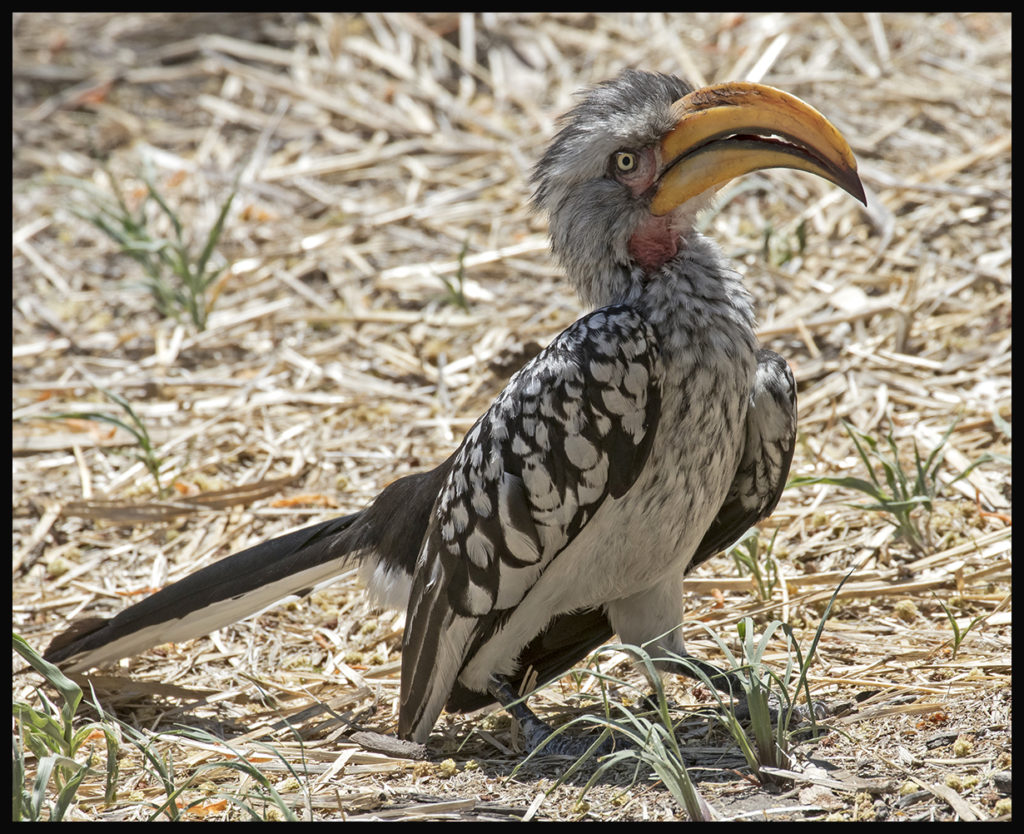
Southern yellow-billed hornbill, aka the Flying Banana

The Kori Bustard male with breeding neck feathers fluffed. Bustards are the heaviest flying birds.

Wild Cat, from whence all other cats evolved, presumably.

Slender Mongoose resting. Mongooses are the African weasel equivalents.

I’m impressed!

Ground squirrel male, duh!

Pair of the shy, small Steenboks.

Pronking practice.

Springbok male.

Pronking is the stiff-legged jump of springboks.

A distant honey badger digs as a goshawk looks on.

Leopard tortoises are fairly common. They are particularly fond of eating hyena poop which is rich in calcium content. It helps with shell growth.

Tranquil evening in the Kalahari.
The Kalahari, which we thought was a desert, is really an arid area, not true desert. Rain was so plentiful last season the trees were still green. However, decades ago, to prevent disease from wild animals from spreading to cattle north of the park, a veterinary fence was erected. While the efficacy of the fence is questionable, it did prevent natural migration behavior. In the late 70’s a horrible drought seared the Kalahari. Migrating wildebeests and others tried to get to water, but were stopped by the fence. Hundreds of thousands died. To prevent another occurrence, the wildlife department drilled a few wells. We looked at one, called Sunday Whole, which was a brackish, slimy basin…but it was water.

Joseph checks the salinity of the bore hole water.
FYI: For those considering a trip to Botswana: There are two seasons in Botswana, wet and dry. Safaris done in the different time periods have their advantages and disadvantages. We chose end of Nov. through mid-January to leave the cold of the northern hemisphere behind and to miss the height of the rainy period. It is a transition period from the very hot and dry, to hot and wet. It is the low season. Prices and tourist numbers are lower. By December enough rains had come to green the leaves and start the grass growing. Animals leave the highly concentrated areas around the few water holes for the greening pastures beyond. Migrant birds arrive to breed and locals are already nesting or getting ready to. Grasses are still short enough to see game animals easily. Most animals have babies with them. Some people prefer to visit in the dry season (September through October), even though it’s very hot and brown then, because of the animal concentrations. April through August is the high tourist season. Temperatures are mild, grass is plentiful, rivers are flowing and the Okavanga delta is flooded. Tourists are everywhere and privacy harder to find. January to March is the rainy season. Most years it’s not a big issue, but there are some years that are too wet and access to parks can be limited.
Until the next post, ciao.
